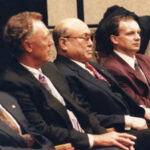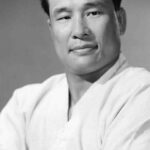- official website -
kyokushin
world federation
About karate
kyokushin
HISTORY OF KARATE KYOKUSHIN
The founder of Kyokushinkai (Japanese Association of the Seekers of the Highest Truth) was the Japanese Masutatsu Oyama (1927 – 1994). The life of this man was extraordinary, and not only because he devoted it entirely to self-improvement and popularization of modern martial arts in its spiritual and physical aspects. It is noteworthy, for example, that in 1945 Oyama joined the squad of suicide aviators (kamikaze), wanting to lay down his life for his beloved homeland – because that’s what he used to say about Japan. He was then saved from death by the end of hostilities. The great personality of this man is evidenced by the fact that already during his lifetime he was called “The Last Samurai”. As it was written in one of the most prestigious magazines devoted to the martial arts of the Far East “Black Belt”: “Oyama not only took over the hardest to meet the ideal of Bushido (the code of ethics of samurai), but went one step further. through self-discipline, it is directly proportional to the degree of success. Fighting karate, when there are firearms in the world, is no longer essential in times of war, it seems something archaic.
In 1936, Masutatsu Oyama obtained a master’s degree in Chinese martial art called kempo, and as a 17-year-old student at Takushoku University, he passed the 2-dan karate exam, which he trained with the greatest master of the time, Gichin Funakoshi. He was also 4th Dan in judo. In 1947, after winning the World Championships in Kyoto, Oyama decided to devote his life entirely to this martial art in the Far East. Following the example of the Buddhist monk Nichiren, who had spent many years in strict training, the Japanese went alone to Mount Kiyosumi. In hermit conditions, for 18 months he perfected his skills in the art of karate and also in Zen. After returning from the mountains, he was the only one in the history of karateka who decided to fight a bull. He was convinced that such a fight would show how much he had improved his mental and physical skills. The clash with the animal took place in Chiba and ended with Oyama’s victory. The bull was killed with a single punch between the eyes.
The creator of Kyokushin decided to propagate his karate all over the world. He was sure that it is not only a martial art, but above all a carrier of the Far East tradition and culture – the ethical values proclaimed by Confucius and Lao-Tse. Oyama always told his students that karate begins and ends with courtesy and that while physical development is the beginning of this martial art, spiritual development is the ultimate goal. To better display the ethical principles of kyokushin, the Japanese created a seven-point moral code for this martial art. It speaks of an obligation to respect elders and parents, to strive for physical and spiritual perfection, and to refrain from violence.
In 1952, Masutatsu Oyama left for the United States, where for 11 months he gave numerous shows of kyokushin art. Among other things, he fought several fights with bulls. After one, one of America’s most prestigious newspapers, The New York Time, called it “God’s Hand.” The Japanese claimed that even a bull of 800 kg can be easily defeated in combat, on one condition – one must not be afraid of him. Oyama’s many travels around the world made kyokushin very popular in a short time. Currently, they are cultivated by over 2 million people around the globe.
In 1974, the International Kyokushin Organization awarded Masutatsu Oyama the highest level of initiation in the art of karate – 9 dan, and then 10. “The Last Samurai” was the author of several books on karate: “What is karate?” (1958), “Here’s Karate” (1965), “Dynamics of Karate” (1966), “Fighting Spirit” (1972), “The Way of Kyokushin” (1976) and others.
DOJO KUN & 11 MOTTO'S OF MAS OYAMA
English Version of Kyokushin Dojo Kun
- We will train our hearts and bodies for a firm unshaking spirit.
- We will pursue the true meaning of the Martial Way, so that in time our senses may be alert.
- With true vigor, we will seek to cultivate a spirit of self denial.
- We will observe the rules of courtesy, respect our superiors, and refrain from violence.
- We will follow our religious principles and never forget the true virtue of humility
- We will look upwards to wisdom and strength, not seeking other desires.
- All our lives, through the discipline of Karate, we will seek to fulfill the true meaning of the Kyokushin Way.
Japanese Version
- Hitotsu, wareware wa, shinshin o renmashi, kakko fubatsu no shingi o kiwameru koto
- Hitotsu, wareware wa, bu no shinzui o kiwame, ki ni hasshi, kan ni bin naru koto
- Hitotsu, wareware wa, shitsujitsu gōken o motte, kokki no seishin o kanyo suru koto
- Hitotsu, wareware wa, reisetsu o omonji, chōjō o keishi sobō no furumai o tsutsushimu koto
- Hitotsu, wareware wa, shinbutsu o tōtobi, kenjō no bitoku o wasurezaru koto
- Hitotsu, wareware wa, chisei to tairyoku to o kōjō sase, koto ni nozonde ayamatazaru koto
- Hitotsu, wareware wa, shōgai no shūgyō o karate no michi ni tsūji, Kyokushin no michi o mattō suru koto
Mas Oyama summed up his entire martial arts philosophy in eleven mottos, known as the Zayu no Mei Juichi Kajo, which are central to the teachings of Kyokushin Karate:
1. The Martial Way begins and ends with courtesy. Therefore, be properly and genuinely courteous at all times.
2. Following the Martial Way is like scaling a cliff – continue upwards without rest. It demands absolute and unfaltering devotion to the task at hand.
3. Strive to seize the initiative in all things, all the time guarding against actions stemming from selfish animosity or thoughtlessness.
4. Even for the Martial Artist, the place of money cannot be ignored. Yet one should be careful never to become attached to it.
5. The Martial Way is centered in posture. Strive to maintain correct posture at all times.
6. The Martial Way begins with one thousand days and is mastered after ten thousand days of training.
7. In the Martial Arts, introspection begets wisdom. Always see contemplation on your actions as an opportunity to improve.
8. The nature and purpose of the Martial Way is universal. All selfish desires should be roasted in the tempering fires of hard training.
9. The Martial Arts begin with a point and end in a circle. Straight lines stem from this principle.
10. The true essence of the Martial Way can only be realized through experience. Knowing this, learn never to fear its demands.
11. Always remember, in the Martial Arts, the rewards of a confident and grateful heart are truly abundant.
Training
Kyokushin karate training is mainly based on five elements:
kihon – basic techniques. (see List of techniques in Kyokushin). Kihon is aimed at teaching karate practitioner the correct technique of strikes, kicks and blocks. During the kihon, the practitioners stand in rows in the order of their grades. The techniques are performed after the instructor gives the command.
ido geiko – to move
kata – formal defense and attack arrangements. Kata is the traditional way of imparting knowledge of karate. In medieval Okinawa, where karate originated, a law was introduced forbidding peasants from possessing all weapons – even knives and axes, and it was also forbidden to practice martial arts. In order to defend themselves, the Okinawans invented various combat systems, i.e. kata, which allowed them to practice in solitude (for fear of informers). The kata is performed similarly to the kihon – in rows, according to the degrees you have, after the instructor’s command.
kumite – free fight. Kumite is the essence of kyokushin karate. Masutatsu Ōyama claimed that karate without a fight is just a dance. For the sake of the health of the exercisers, the possibility of attacking the knees, spine or head was disabled during sports fights (most foot techniques can be used on the head).
iken – training techniques derived from the Chinese style of wushu yiquan. Mainly cultivated in Japan and Brazil. The core of Iken training is the use of mental training, work on the “unity of mind and body”, flexibility of movements and perfect mastery of balance and the balance of speed and pace in combat. Characteristic for Iken are the so-called explosive strikes, shi-li techniques, training in static positions.
The ultimate goal of karate training is the spiritual development of the practitioner. It is done through demanding physical exercises – during the training, the karate adept overcomes his weakness, shyness and indecision, thanks to which he can become a better person. Every adept of kyokushin karate should know the oath (dojo kun) and the etiquette of the dojo.
Kata in kyokushin karate, or formal systems, is a strictly defined sequence of movements (i.e. blocks, strikes, kicks) performed in various positions. In kyokushin, they were adopted and perfected from other karate schools practiced by Masutatsu Ōyama, ie Shotokan, Goju-ryu, and Chinese Kempo karate. List of kata practiced in kyokushin karate:
taikyoku sono ichi / ni / san (basic) – also practiced in the ura (reverse) version
sokugi sono ichi / ni / san
pinan sono ichi / ni / san / yon / go – also practiced in the ura (reverse) version
sanchin
tsuki no kata
gekisai dai
geksai sho
saiha
yantsu
kanku dai
seienchin
garyu – the only original kata invented by Masutatsu Oyama
seipai
tensho
sushiho
Belts
Students degree:
10. kyū – orange belt
9. kyū – an orange belt with a blue stripe
8. kyū – the blue belt
7. kyū – blue belt with a yellow stripe
6. kyū – yellow belt
5. kyū – a yellow belt with a green stripe
4. kyū – green belt
3. kyū – a green belt with a brown stripe
2. kyū – brown belt
1. kyū – a brown belt with a black stripe
and master degrees:
black belt with golden stripe – 1 dan (shodan)
black belt with two golden stripes – 2 dan (nidan)
black belt with three golden stripes- 3rd dan (sandan)
all the way to the black belt with 10 bars, which is the highest step in kyokushin karate.
Webmaster
- sensei Krzysztof R. Kopciowski (3rd dan)
- kkopciowski@gmail.com
- Kyokushin World Federation 2021

















